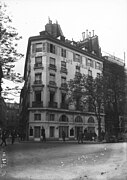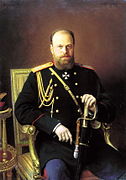-
Café Anglais in 1913
-
Tsarevich Alexander
(later Tsar Alexander III)
The Dîner des trois empereurs or Three Emperors Dinner was a banquet held at Café Anglais in Paris, France on 7 June 1867. [1] It consisted of 16 courses with eight wines served over eight hours.
Overview
The Three Emperors Dinner was prepared by chef Adolphe Dugléré at the request of King William I of Prussia who frequented the cafe during the Exposition Universelle. He requested a meal to be remembered and at which no expense was to be spared for himself and his guests, Tsar Alexander II of Russia, plus his son the tsarevitch (who later became Tsar Alexander III), and Otto von Bismarck.
The name "Three Emperors Dinner" is something of a misnomer and apparently was applied retrospectively (apparently in analogy to the Battle of the Three Emperors), as only Alexander II bore the title of Emperor at the time. Wilhelm I would not be proclaimed Kaiser (emperor) until 1871, whereas Alexander III would only ascend the Imperial Russian throne in 1881 after his father's assassination.
The cellar master, Claudius Burdel, was instructed to accompany the dishes with the greatest wines in the world, including a Roederer champagne in a special lead glass bottle, so Tsar Alexander could admire the bubbles and golden colour. [2]
The banquet consisted of 16 courses with eight wines served over eight hours. The cost of the meal was 400 francs per person [3] (over €9,000 in 2024 prices). The high price of the wines served contributed to the high price of the meal. [1]
At 1 o'clock in the morning, Tsar Alexander is reported to have complained that the meal had not contained foie gras. Burdel explained that it was not the custom in French cuisine to eat foie gras in June. The tsar was satisfied with the answer. Each emperor was sent a terrine of foie gras as a gift the following October. [4]
The table used for the banquet and a copy of the menu is on display at La Tour d'Argent restaurant in Paris. [5]
Menu
The menu included the following, among the 16 courses:
| MENU
Impératrice Relevés Soufflé à la reine Entrées Poulet à la portugaise Digérer Rôts Canetons à la rouennaise Entremets Aubergines à l'espagnole Dessert Bombe glacée VINS Madère retour de l'Inde 1810 |
Potage impératrice consists of a
chicken stock thickened with
tapioca and finished with
egg
yolks and
cream, to which
poached rounds of
chicken
forcemeat,
cockscombs,
cocks'
kidneys and green
peas are added.
[6]
Potage fontanges is a
purée of fresh peas diluted with
consommé with the addition of a
chiffonade of
sorrel and sprigs of
chervil.
[7]
Soufflé à la reine is a chicken
soufflé with
truffles
[7]
Sauce vénitienne is a
sauce of
white wine,
tarragon
vinegar,
shallots and chervil, mounted with
butter and finished with chopped chervil and tarragon.
[6]
Selle de mouton purée Bretonne is saddle of
mutton with a purée of
broad beans bound with
Breton sauce.
[7]
Poulet à la portugaise is whole chicken roasted with a covering of
adobo
paste consisting of
tomato,
red bell pepper,
garlic,
origanum,
paprika,
cayenne pepper,
brown sugar,
lemon juice, white wine, chicken stock and
olive oil, stuffed with tomato flavoured
rice.
[6]
Pâté chaud de cailles is warm
pâté of
quail.
Homard à la parisienne is
lobster cooked in
court bouillon, cut into slices and glazed with
aspic, with a
garnish of tomatoes stuffed with a
macédoine of
vegetables, dressed with a mixture of
mayonnaise and aspic and garnished with sliced truffle.
Canetons à la rouennaise is a dish of
roast
duckling stuffed with
forcemeat. The legs and breasts are removed, the legs are grilled and the breasts are thinly sliced and arranged around the stuffing. The remaining carcass is pressed in a poultry press to extract all the juices and is added to a
Rouennaise sauce, which is poured over the sliced duck.
[6] (This dish is today the speciality of the house at
La Tour d'Argent.)
[8]
Ortolans sur canapés,
ortolans (now a
protected species) on
toast.
Aubergines à l'espagnole is a dish of
aubergine shells filled with chopped aubergine, tomato and
ham and a
gruyère
gratin.
Cassolette princesse, (a.k.a. Cassolette argenteuil), A
cassolette with a border of
duchesse potatoes and an
asparagus filling in
cream sauce.
[7]
Bombe glacée is an
ice cream dessert.
[7]
– Source: [2]
Re-creation
Australian chef Shannon Bennett attempted to recreate the banquet in 2002. It took six months to plan and required some changes due to key ingredients and wines no longer being available. Even using the nearest modern equivalent ingredients and wines, the cost of the meal was $7,500 per person. The Australian Broadcasting Corporation broadcast the documentary Three Emperors Dinner about the original banquet and the modern recreation in 2003. [9]
See also
Gallery
References
- ^ a b Frost, W.; Laing, J. (2016). Gastronomy, Tourism and the Media. Aspects of Tourism. Channel View Publications. p. 57. ISBN 978-1-84541-576-1.
- ^ a b "Menus d'hier". Menus.free.fr. Retrieved 27 April 2011.
- ^ Jean Conil (1952). For epicures only. T.W. Laurie. p. 47.
- ^ "Le foie gras des Trois Empereurs". La Tour d'Argent.
- ^ "La "Dîner des Trois Empereurs". La Tour d'Argent. Archived from the original on 2011-08-05.
- ^ a b c d August Escoffier (1907), Le Guide culinaire
- ^ a b c d e Larousse Gastronomique (1961), Crown Publishers (Translated from the French, Librairie Larousse, Paris (1938))
- ^ "Duck Tour d'Argent". Fxcuisine.com. 1 December 2006. Retrieved 27 April 2011.
-
^
"Three Emperors Dinner". Australian Broadcasting Corporation. 4 March 2003.
{{ cite web}}: CS1 maint: url-status ( link)




